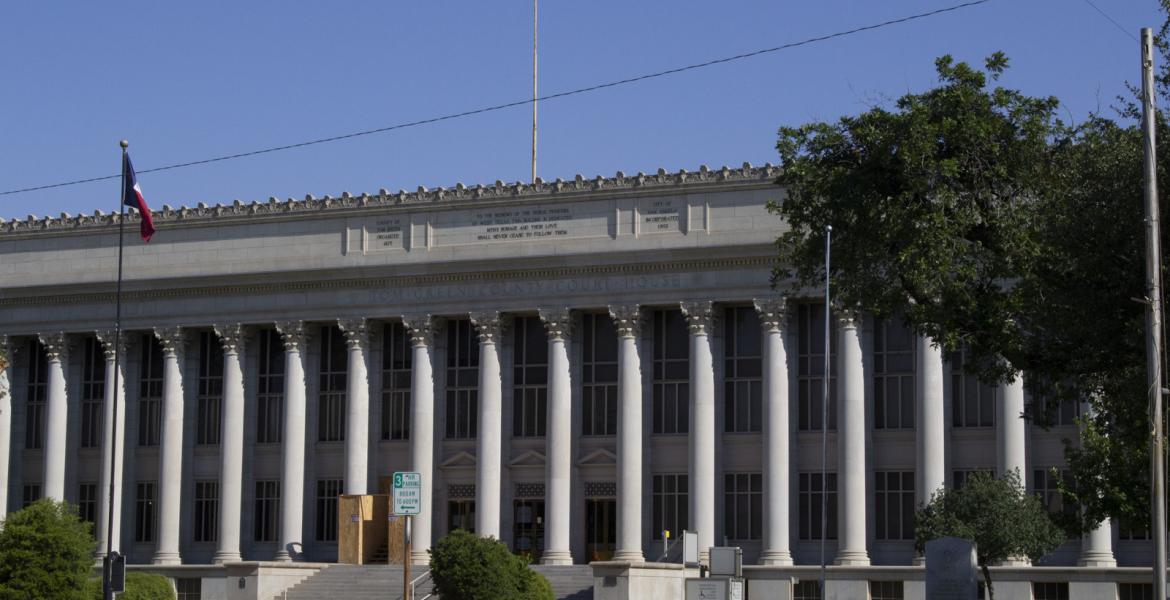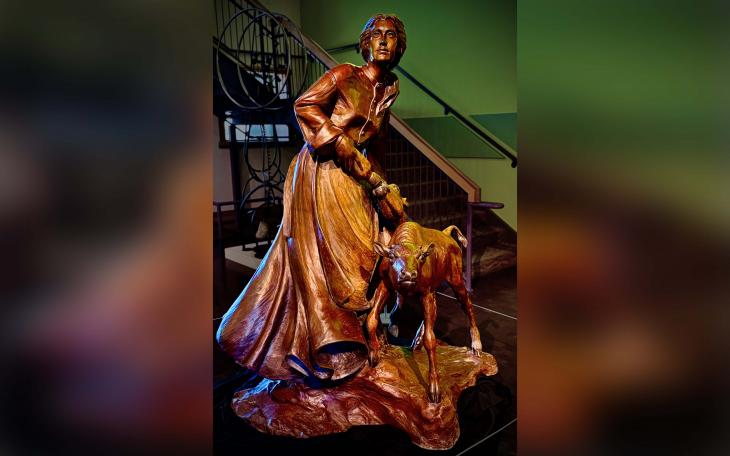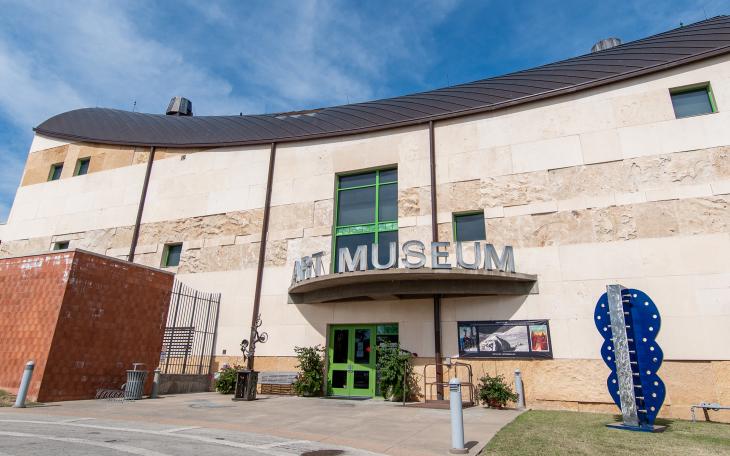“Any DBs? Any dead bodies?” ASU Police Chief James Adams called through a Plaza Verde residence hall on Wednesday morning. Behind him, a number of students with bloody injuries ranging from minor to critical shuffled into the lobby.
‘I’m going to have you lie over this chair,’ Chief Adams directed a girl with a gunshot wound to the head to a nearby table. He told her to lie back with her arms draped over the sides of the rests and her head relaxed. She immediately slipped into character.
[[{"fid":"14053","view_mode":"preview","type":"media","attributes":{"alt":"Makeup artists from Goodfellow AFB apply moulage to ASU students participating in the training. (LIVE! Photo/Chelsea Reinhard)","title":"Makeup artists from Goodfellow AFB apply moulage to ASU students participating in the training. (LIVE! Photo/Chelsea Reinhard)","class":"media-element file-preview imgbody"}}]]
Above: Makeup artists from Goodfellow AFB apply moulage to ASU students participating in the training. (LIVE! Photo/Chelsea Reinhard)
As students took their positions, one-by-one dropping to the floor and lying at various angles, men with bright orange safety vests and radios walked through, the words Exercise Evaluation Team printed in black across their backs.
A few minutes later, two shots rang out and a young man in a red T-shirt and blue jeans ran through the residence hall lobby and out one of the doors. Screams and pleadings for help rose from all over the long, rectangular common area.
“We started doing this in ’04,” Chief Adams explained. “We had a lot of school shootings that were occurring so that’s kind of what sparked the need for us to train. [This is] actually a follow up to some training we did earlier in the month for active shooter.”
[[{"fid":"14054","view_mode":"preview","type":"media","attributes":{"alt":"The shooter roams the halls of the Plaze Verde dormitory. (LIVE! Photo/Chelsea Reinhard)","title":"The shooter roams the halls of the Plaze Verde dormitory. (LIVE! Photo/Chelsea Reinhard)","class":"media-element file-preview imgbody"}}]]
Above: The shooter roams the halls of the Plaze Verde dormitory. (LIVE! Photo/Chelsea Reinhard)
The previous training involved members of Texas Tech and was held over the span of four days in June, which ultimately brought the university police up to the second certification level for Advance Law Enforcement Rapid Response Training (ALERRT). While the first level focuses on locating and detaining the shooter, the second level begins with basic care for the wounded in a secured area and introduces medical personnel and treatment simulations to the exercises, Adams explained.
Wednesday’s combined role play was a first-time collaboration for the ASUPD and the San Angelo Fire Department, but the exercise also included support from the San Angelo Police Department and Goodfellow Air Force Base.
Medics from the Goodfellow Air Force Base were on hand to lend their creative moulage skills to the exercise, enhancing the realism of medical need as they painted and smeared on layers of silicon, wax and other materials to form convincing entry and exit wounds on the bodies of actors.
After the exercise started, the students fell into their roles, crying for help and begging the officers, who quickly swept through the building in pursuit of the shooter, to come back and care for them.
“Help us!” two young men lying near an exit shouted together.
“I’m bleeding out! I’m bleeding out!” a young woman screamed.
Ten minutes or so elapsed and the officers returned, still brandishing their red-tipped training weapons, and began to secure the area.
[[{"fid":"14055","view_mode":"preview","type":"media","attributes":{"alt":"An officer talks with a victim in the active shooter training. (LIVE! Photo/Chelsea Reinhard)","title":"An officer talks with a victim in the active shooter training. (LIVE! Photo/Chelsea Reinhard)","class":"media-element file-preview imgbody"}}]]
Above: An officer talks with a victim in the active shooter training. (LIVE! Photo/Chelsea Reinhard)
“We have three immediates and four walking wounded,” someone said over the radio. Shortly thereafter medics with the SAFD entered the room and began to simulate treatment, ultimately taking one participant out on a gurney. Only one of the victims died.
“I like to involve the students as much as I can,” said Emergency Management Coordinator Steve Mild. “When it’s [really] happening they can look and say, ‘I’ve seen this happening before. I know what’s happening.’ They can then be a part of the solution, not part of the problem.”
[[{"fid":"14056","view_mode":"preview","type":"media","attributes":{"alt":"Victims lie all over the lobby of the Plaza Verde dormitory. (LIVE! Photo/Chelsea Reinhard)","title":"Victims lie all over the lobby of the Plaza Verde dormitory. (LIVE! Photo/Chelsea Reinhard)","class":"media-element file-preview imgbody"}}]]
Above: Victims lie all over the lobby of the Plaza Verde dormitory. (LIVE! Photo/Chelsea Reinhard)
The students who participated on Wednesday were RAs for the residence hall and said they are actually trained for active shooter situations as part of their responsibility to keep the dorms safe.
“We have had to think about what we have to do to make sure our residents are ok,” said Jaricka Thomas, one of the victims in the role play. “We do have to think about those worst-case scenarios where somebody comes in and is a threat to our university.”
[[{"fid":"14057","view_mode":"preview","type":"media","attributes":{"alt":"Student volunteers show off their wounds. (LIVE! Photo/Chelsea Reinhard)","title":"Student volunteers show off their wounds. (LIVE! Photo/Chelsea Reinhard)","class":"media-element file-preview imgbody"}}]]
Above: Student volunteers show off their wounds. (LIVE! Photo/Chelsea Reinhard)
Thomas and coworker Demarcus Parker agreed that the training was not only realistic, but educational, providing each with a better understanding of what takes place during active shooter situations. Parker said that although San Angelo has never had an active shooter threat, gun safety is something students are concerned with locally.
“I’ve thought about it, especially with just the open carry on campus that’s about to take place,” he explained. “I think that it’s a situation that needs to be addressed and needs to be practiced often.”
After the exercise, members of the evaluation team, the ASU Chief of Police, and members of the SAFD and SAPD convened at a table to hash out how things went and what was learned from the experience.
[[{"fid":"14058","view_mode":"preview","type":"media","attributes":{"alt":"A victim is transported out of the Plaza Verde residence hall. (LIVE! Photo/Chelsea Reinhard)","title":"A victim is transported out of the Plaza Verde residence hall. (LIVE! Photo/Chelsea Reinhard)","class":"media-element file-preview imgbody"}}]]
Above: A victim is transported out of the Plaza Verde residence hall. (LIVE! Photo/Chelsea Reinhard)
“To leave here is to know that our radio worked,” SAPD Lt. Les Bird said. “On every event, communication is an issue and a lot of times the radio didn’t do right. Today, the radios did what they were supposed to do.”
Lt. Bird explained that each of the local law enforcement agencies utilize different systems for radio communications, which poses a hurdle to working combined efforts. When they do come together they use a patch, or a common or close channel, and attempt to communicate that way, but it hasn’t always worked.
Chief Adams agreed with Bird, noting that it isn’t only overcoming complications with the communications equipment that needs to be practiced, but in working with other agencies on such a large scale.
[[{"fid":"14059","view_mode":"preview","type":"media","attributes":{"alt":"Military personnel escort a dog capable of sniffing out bombs onto campus. (LIVE! Photo/Chelsea Reinhard)","title":"Military personnel escort a dog capable of sniffing out bombs onto campus. (LIVE! Photo/Chelsea Reinhard)","class":"media-element file-preview imgbody"}}]]
Above: Military personnel escort a dog capable of sniffing out bombs onto campus. (LIVE! Photo/Chelsea Reinhard)
“Our department, best-case scenario, I’ve got three guys on,” Adams said. “In a matter of minutes, you’re going to have 20, 30 other officers that are showing up here. I’m comfortable with our guys coming in and what they need to do in here, but it’s that whole coordinating of everybody else that’s showing up.”
Adams said the personnel from the various agencies worked together well on Wednesday and deemed the training an overall success.
“It was a good exercise, I think it did what it needed to do; it met the objectives,” Adams said. “But it just further underscores the need for us to continue to work together. You’ve got to train together, because if you don’t, when the situation does in fact happen, you’re not going to really be prepared.”
Subscribe to the LIVE! Daily
Required






Comments
Listed By: senior swami
I can see several agencies involved, other bureaucracies, administration, etc. and that such an exercise in futility has been going on since mid 2000s. Other than financial, what's the total holisitc cost of this self-fulfilling, reactive policy? Will it, at a minimum, become proactive once open carry college campus hunting season opens? I wonder if other colleges, high schools, junior highs and elementary schools in other western industrialized countries have to conduct these drills? If not, why?
- Log in or register to post comments
PermalinkPost a comment to this article here: